High-Performance Resistive Switching in Solution-Derived IGZO:N Memristors by Microwave-Assisted Nitridation
Abstract
1. Introduction
2. Experimental Methods
2.1. Material Specifications
2.2. IGZO Solution Synthesis Procedure
2.3. IGZO:N Memristor Devices Fabrication
2.4. Characterization of IGZO:N Memristor Devices
3. Results and Discussion
3.1. Microwave-Assisted Nitridation Effect
3.2. Chemical Compositions of IGZO:N Nanocomposites
3.3. Resistive Switching Operations and Stability Evaluation
3.4. Current Conduction Mechanism of IGZO:N Memristor
3.5. Multi-Level Operations and Synaptic Weight Modulation
4. Conclusions
Author Contributions
Funding
Informed Consent Statement
Data Availability Statement
Conflicts of Interest
References
- Wang, Y.G. Applications of Memristors in Neural Networks and Neuromorphic Computing: A Review. Int. J. Mach. Learn. Comput. 2021, 11, 350–356. [Google Scholar]
- Zhang, Z.; Wang, Z.; Shi, T.; Bi, C.; Rao, F.; Cai, Y.; Liu, Q.; Wu, H.; Zhou, P. Memory materials and devices: From concept to application. InfoMat 2020, 2, 261–290. [Google Scholar] [CrossRef]
- Gupta, V.; Kapur, S.; Saurabh, S.; Grover, A. Resistive Random Access Memory: A Review of Device Challenges. IETE Tech. Rev. 2019, 37, 377–390. [Google Scholar] [CrossRef]
- Banerjee, W. Challenges and Applications of Emerging Nonvolatile Memory Devices. Electronics 2020, 9, 1029. [Google Scholar] [CrossRef]
- Chen, A. Emerging research device roadmap and perspectives. In Proceedings of the 2014 IEEE International Conference on IC Design & Technology, Austin, TX, USA, 28–30 May 2014; pp. 1–4. [Google Scholar]
- Chua, L. Memristor-The missing circuit element. IEEE Trans. Circuit Theory 1971, 18, 507–519. [Google Scholar] [CrossRef]
- Khalid, M. Review on Various Memristor Models, Characteristics, Potential Applications, and Future Works. Trans. Electr. Electron. Mater. 2019, 20, 289–298. [Google Scholar] [CrossRef]
- Li, Y.; Wang, Z.; Midya, R.; Xia, Q.; Yang, J.J. Review of memristor devices in neuromorphic computing: Materials sciences and device challenges. J. Phys. D Appl. Phys. 2018, 51, 503002. [Google Scholar] [CrossRef]
- Chang, T.-C.; Chang, K.-C.; Tsai, T.-M.; Chu, T.-J.; Sze, S.M. Resistance random access memory. Mater. Today 2016, 19, 254–264. [Google Scholar] [CrossRef]
- Nail, C.; Molas, G.; Blaise, P.; Piccolboni, G.; Sklenard, B.; Cagli, C.; Bernard, M.; Roule, A.; Azzaz, M.; Vianello, E.; et al. Understanding RRAM endurance, retention and window margin trade-off using experimental results and simulations. In Proceedings of the 2016 IEEE International Electron Devices Meeting (IEDM), San Francisco, CA, USA, 3–7 December 2016; pp. 4–5. [Google Scholar]
- Ielmini, D. Resistive switching memories based on metal oxides: Mechanisms, reliability and scaling. Semicond. Sci. Technol. 2016, 31, 063002. [Google Scholar] [CrossRef]
- Xie, H.; Liu, Q.; Li, Y.; Lv, H.; Wang, M.; Liu, X.; Sun, H.; Yang, X.; Long, S.; Liu, S.; et al. Nitrogen-induced improvement of resistive switching uniformity in a HfO2-based RRAM device. Semicond. Sci. Technol. 2012, 27, 125008. [Google Scholar] [CrossRef]
- Hwang, Y.H.; Hwang, I.; Cho, W.J. Composition-ratio influence on resistive switching behavior of solution-processed InGaZnO-based thin-film. J. Nanosci. Nanotechnol. 2014, 14, 8196–8200. [Google Scholar] [CrossRef]
- Gan, K.-J.; Liu, P.-T.; Ruan, D.-B.; Chiu, Y.-C.; Sze, S.M. Annealing effects on resistive switching of IGZO-based CBRAM devices. Vacuum 2020, 180, 109630. [Google Scholar] [CrossRef]
- Teng, L.-F.; Liu, P.-T.; Lo, Y.-J.; Lee, Y.-J. Effects of microwave annealing on electrical enhancement of amorphous oxide semiconductor thin film transistor. Appl. Phys. Lett. 2012, 101, 132901. [Google Scholar] [CrossRef]
- Hwang, Y.-H.; An, H.-M.; Cho, W.-J. Performance improvement of the resistive memory properties of InGaZnO thin films by using microwave irradiation. Jpn. J. Appl. Phys. 2014, 53, 04EJ04. [Google Scholar] [CrossRef]
- Majumder, A.; Gupta, R.; Jain, A. Microwave-assisted synthesis of nitrogen-containing heterocycles. Green Chem. Lett. Rev. 2012, 6, 151–182. [Google Scholar] [CrossRef]
- Xia, X.; Cheng, C.-F.; Zhu, Y.; Vogt, B.D. Ultrafast microwave-assisted synthesis of highly nitrogen-doped ordered mesoporous carbon. Microporous Mesoporous Mater. 2021, 310, 110639. [Google Scholar] [CrossRef]
- Kamiya, T.; Hosono, H. Material characteristics and applications of transparent amorphous oxide semiconductors. NPG Asia Mater. 2010, 2, 15–22. [Google Scholar] [CrossRef]
- Hosono, H. Ionic amorphous oxide semiconductors: Material design, carrier transport, and device application. J. Non Cryst. Solids 2006, 352, 851–858. [Google Scholar] [CrossRef]
- Chen, M.-C.; Chang, T.-C.; Huang, S.-Y.; Chen, S.-C.; Hu, C.-W.; Tsai, C.-T.; Sze, S.M. Bipolar Resistive Switching Characteristics of Transparent Indium Gallium Zinc Oxide Resistive Random Access Memory. Electrochem. Solid-State Lett. 2010, 13, H191–H193. [Google Scholar] [CrossRef]
- Kim, C.H.; Hwang, H.J.; Jang, Y.H.; Song, C.H.; Yang, Y.S.; Cho, J.H. Bistable resistance memory switching effect in amorphous InGaZnO thin films. Appl. Phys. Lett. 2010, 97, 062109. [Google Scholar] [CrossRef]
- Tarey, R.D.; Raju, T. A method for the deposition of transparent conducting thin films of tin oxide. Thin Solid Films 1985, 128, 181–189. [Google Scholar] [CrossRef]
- Sallis, S.; Quackenbush, N.F.; Williams, D.S.; Senger, M.; Woicik, J.C.; White, B.E.; Piper, L.F. Deep subgap feature in amorphous indium gallium zinc oxide: Evidence against reduced indium. Phys. Status Solidi 2015, 212, 1471–1475. [Google Scholar] [CrossRef]
- Chen, X.; He, G.; Lv, J.; Liu, M.; Wang, P.; Chen, X.; Sun, Z. Modification of band offsets of InGaZnO4/Si heterojunction through nitrogenation treatment. J. Alloys Compd. 2015, 647, 1035–1039. [Google Scholar] [CrossRef]
- Zheng, C.; He, G.; Chen, X.; Liu, M.; Lv, J.; Gao, J.; Zhang, J.; Xiao, D.; Jin, P.; Jiang, S.; et al. Modification of band alignments and optimization of electrical properties of InGaZnO MOS capacitors with high-k HfOxNy gate dielectrics. J. Alloys Compd. 2016, 679, 115–121. [Google Scholar] [CrossRef]
- Jeon, J.-H.; Cho, W.-J. Multi- and single-step in situ microwave annealing as low-thermal-budget techniques for solution-processed indium–gallium–zinc oxide thin films. Semicond. Sci. Technol. 2018, 34, 015006. [Google Scholar] [CrossRef]
- Misha, S.H.; Tamanna, N.; Woo, J.; Lee, S.; Song, J.; Park, J.; Lim, S.; Hwang, H. Effect of Nitrogen Doping on Variability of TaOx -RRAM for Low-Power 3-Bit MLC Applications. ECS Solid State Lett. 2015, 4, P25–P28. [Google Scholar] [CrossRef]
- Kim, W.; Park, S.I.; Zhang, Z.; Wong, S. Current Conduction Mechanism of Nitrogen-Doped AlOx RRAM. IEEE Trans. Electron Devices 2014, 61, 2158–2163. [Google Scholar] [CrossRef]
- Wong, H.S.P.; Lee, H.Y.; Yu, S.; Chen, Y.S.; Wu, Y.; Chen, P.S.; Lee, B.; Chen, F.T.; Tsai, M.J. Metal–oxide RRAM. Proc. IEEE 2012, 100, 1951–1970. [Google Scholar] [CrossRef]
- Chen, M.-C.; Chang, T.-C.; Tsai, C.-T.; Huang, S.-Y.; Chen, S.-C.; Hu, C.-W.; Sze, S.M.; Tsai, M.-J. Influence of electrode material on the resistive memory switching property of indium gallium zinc oxide thin films. Appl. Phys. Lett. 2010, 96, 262110. [Google Scholar] [CrossRef]
- Hsu, C.H.; Fan, Y.S.; Liu, P.T. Multilevel resistive switching memory with amorphous InGaZnO-based thin film. Appl. Phys. Lett. 2013, 102, 062905. [Google Scholar] [CrossRef]
- Wu, M.-C.; Jang, W.-Y.; Lin, C.-H.; Tseng, T.-Y. A study on low-power, nanosecond operation and multilevel bipolar resistance switching in Ti/ZrO2/Pt nonvolatile memory with 1T1R architecture. Semicond. Sci. Technol. 2012, 27, 065010. [Google Scholar] [CrossRef][Green Version]
- Schimizu, T.; Koyama, M. Control of electronic properties of HfO2 with fluorine doping from first-principles. Appl. Surf. Sci. 2008, 254, 6109–6111. [Google Scholar] [CrossRef]
- Li, L.; Li, W.; Zhu, C.; Mao, L.-F. The Dopant Local Effect on the Stability of an Oxygen Vacancy and the Reliability of a Conductive Filament in Rutile Titanium Dioxide. Phys. Status Solidi (b) 2019, 257, 1900455. [Google Scholar] [CrossRef]
- Chiu, F.-C. A Review on Conduction Mechanisms in Dielectric Films. Adv. Mater. Sci. Eng. 2014, 2014, 1–18. [Google Scholar] [CrossRef]
- Kim, T.W.; Baek, I.J.; Cho, W.J. Resistive switching characteristics of solution-processed Al–Zn–Sn–O films annealed by microwave irradiation. Solid-State Electron. 2018, 140, 122–128. [Google Scholar] [CrossRef]
- Kim, K.M.; Choi, B.J.; Shin, Y.C.; Choi, S.; Hwang, C.S. Anode-interface localized filamentary mechanism in resistive switching of TiO2 thin films. Appl. Phys. Lett. 2007, 91, 012907. [Google Scholar] [CrossRef]
- Pei, Y.; Mai, B.; Zhang, X.; Hu, R.; Li, Y.; Chen, Z.; Fan, B.; Liang, J.; Wang, G. Forming Free Bipolar ReRAM of Ag/a-IGZO/Pt with Improved Resistive Switching Uniformity Through Controlling Oxygen Partial Pressure. J. Electron. Mater. 2014, 44, 645–650. [Google Scholar] [CrossRef]
- Wang, Z.Q.; Xu, H.Y.; Li, X.H.; Zhang, X.T.; Liu, Y.X. Flexible Resistive Switching Memory Device Based on Amorphous InGaZnO Film With Excellent Mechanical Endurance. IEEE Electron Device Lett. 2011, 32, 1442–1444. [Google Scholar] [CrossRef]
- Bousoulas, P.; Stathopoulos, S.; Tsialoukis, D.; Tsoukalas, D. Low-Power and Highly Uniform 3-b Multilevel Switching in Forming Free TiO2−x-Based RRAM With Embedded Pt Nanocrystals. IEEE Electron Device Lett. 2016, 37, 874–877. [Google Scholar] [CrossRef]
- Ambrogio, S.; Balatti, S.; Cubeta, A.; Calderoni, A.; Ramaswamy, N.; Ielmini, D. Understanding switching variability and random telegraph noise in resistive RAM. In Proceedings of the 2013 IEEE International Electron Devices Meeting, Washington, DC, USA, 9–11 December 2013; pp. 31–35. [Google Scholar]
- Wang, C.; Wu, H.; Gao, B.; Zhang, T.; Yang, Y.; Qian, H. Conduction mechanisms, dynamics and stability in ReRAMs. Microelectron. Eng. 2018, 187–188, 121–133. [Google Scholar] [CrossRef]
- Prakash, A.; Hwang, H. Multilevel Cell Storage and Resistance Variability in Resistive Random Access Memory. Phys. Sci. Rev. 2016, 1. [Google Scholar] [CrossRef]
- Long, B.; Li, Y.; Jha, R. Switching Characteristics of Ru/HfO2/TiO2−x/Ru RRAM Devices for Digital and Analog Nonvolatile Memory Applications. IEEE Electron Device Lett. 2012, 33, 706–708. [Google Scholar] [CrossRef]
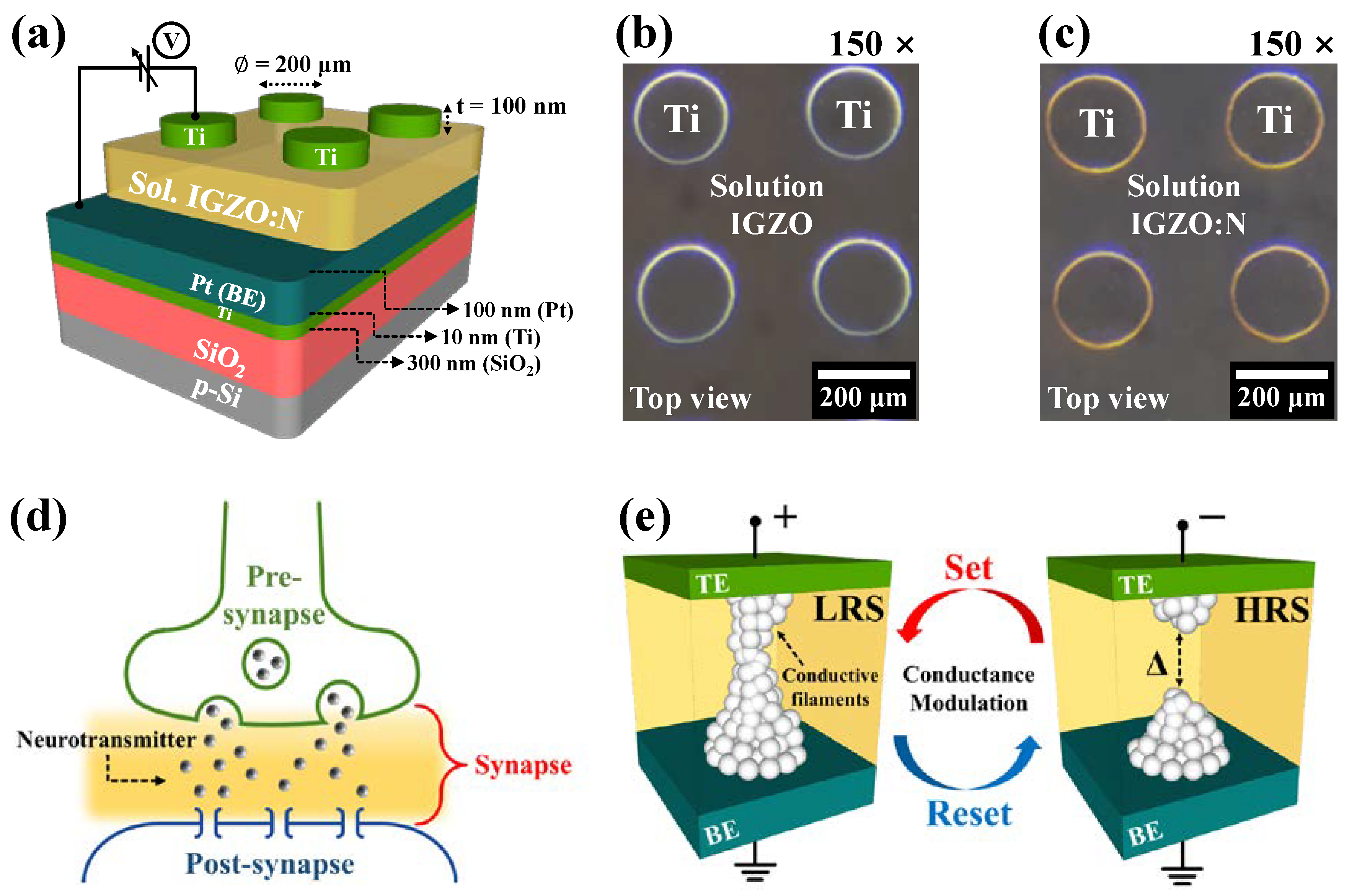

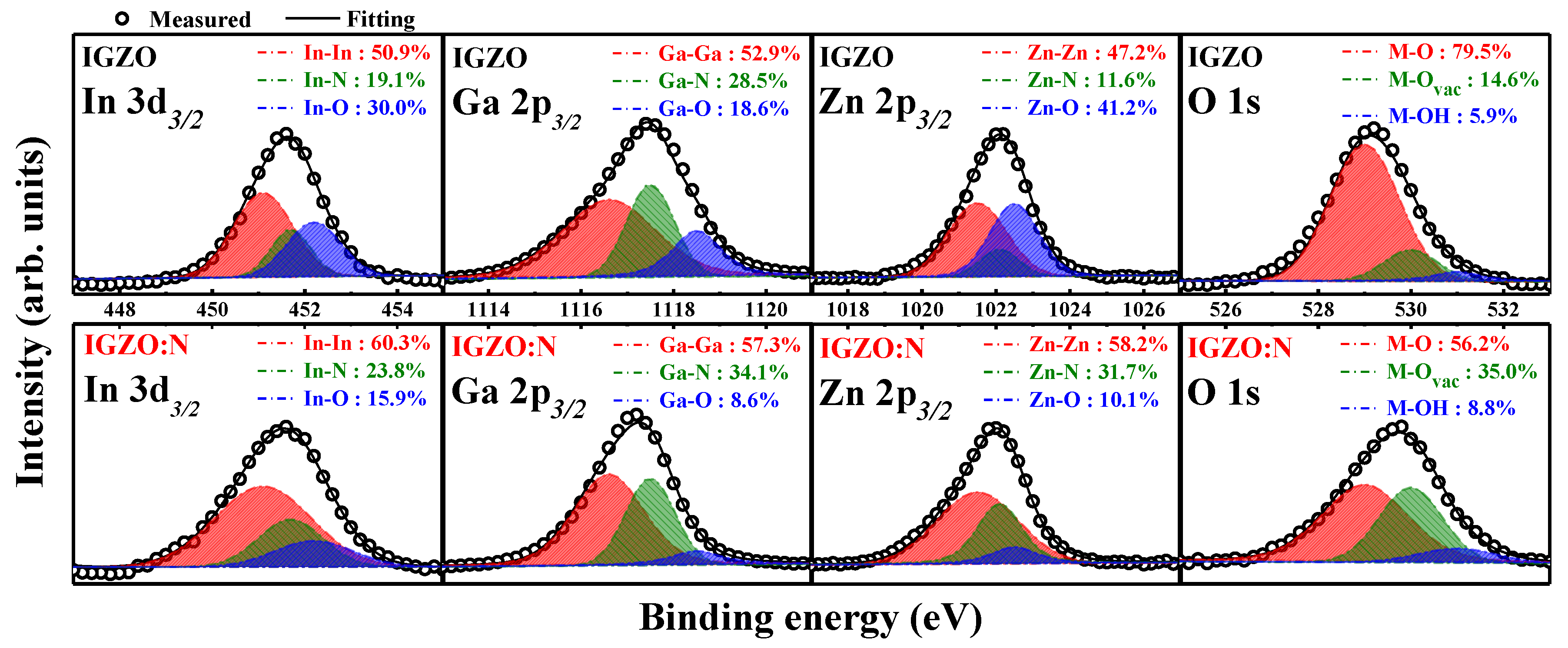


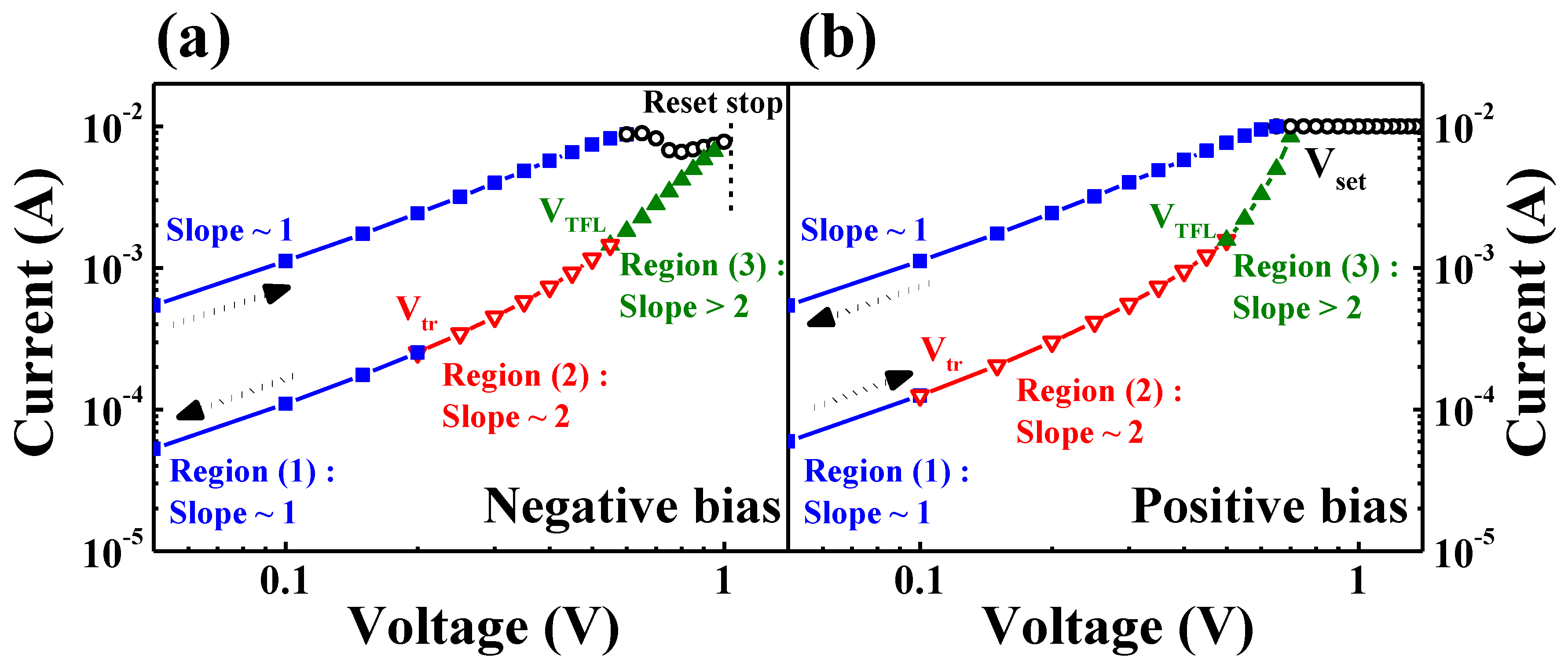
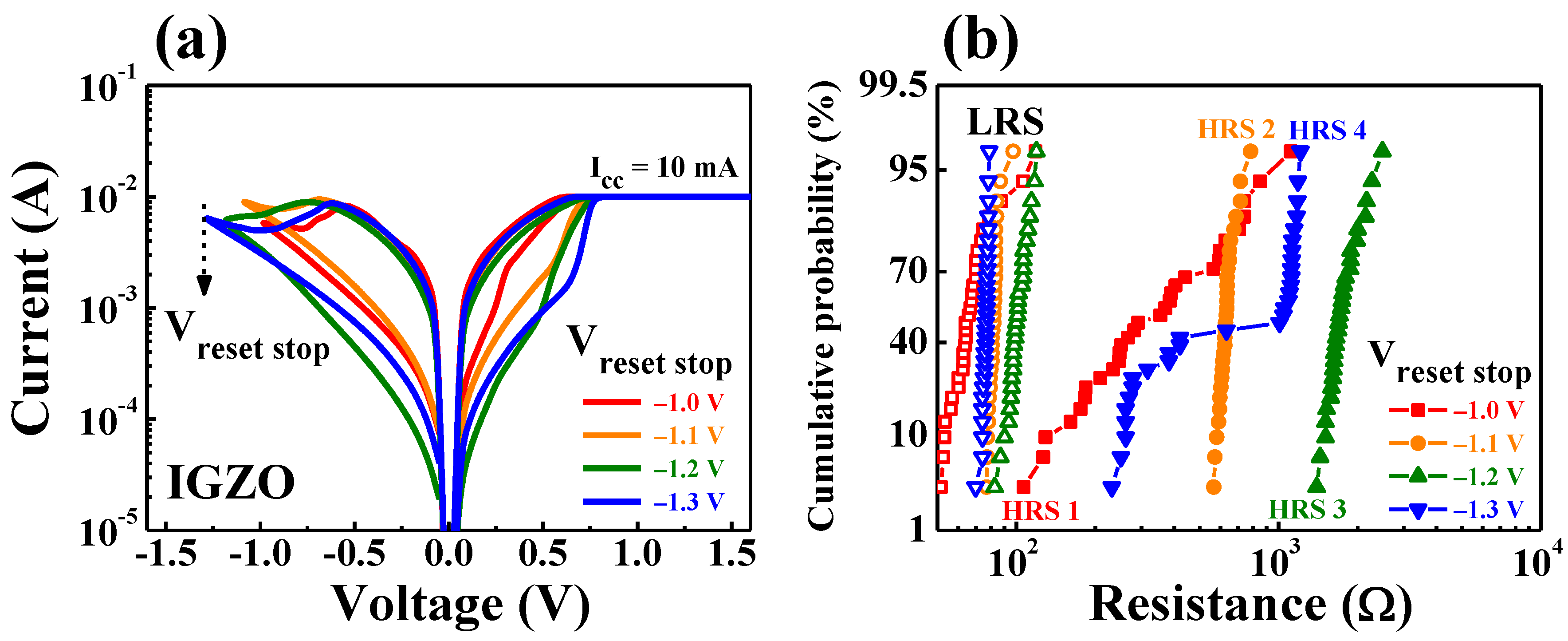
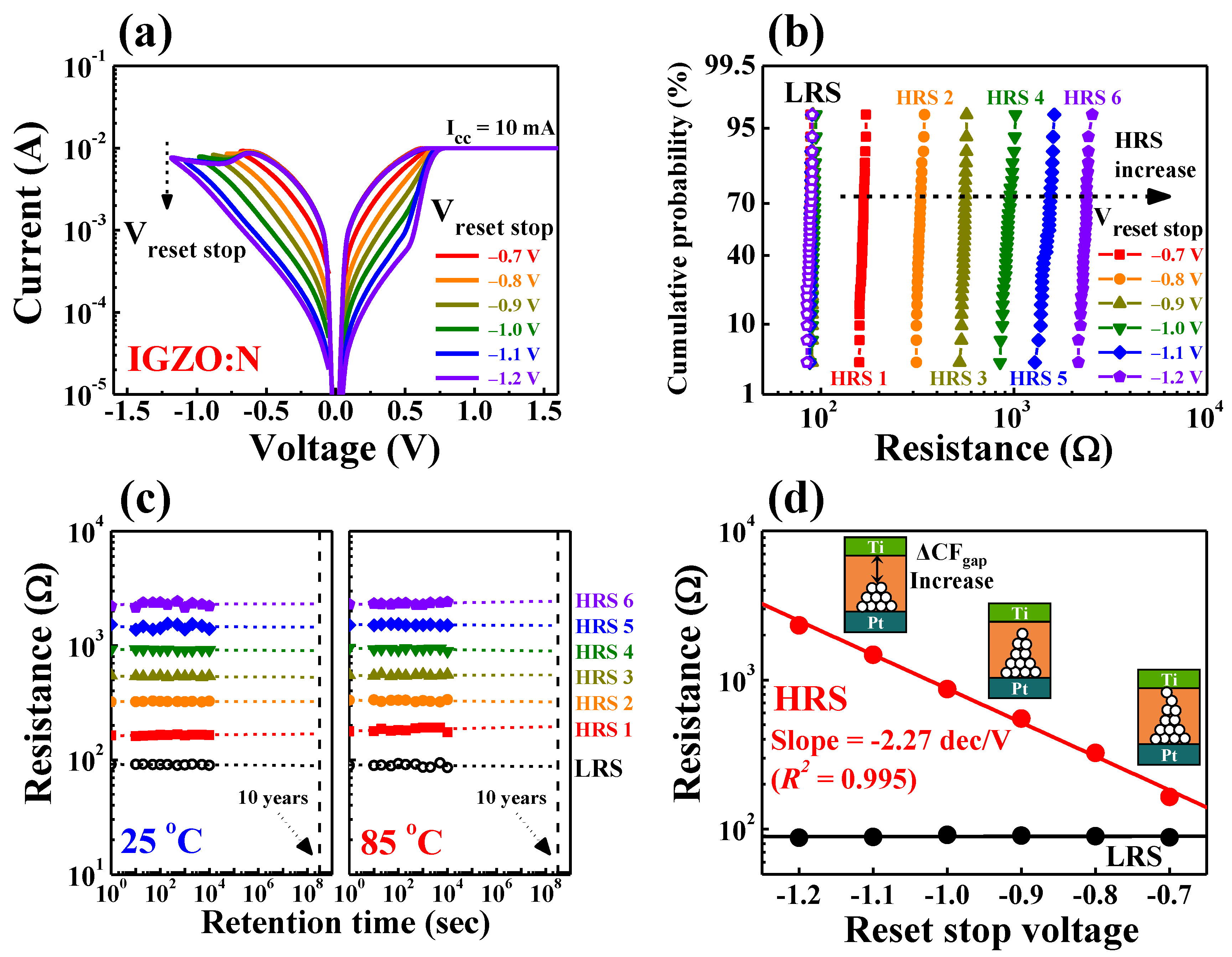
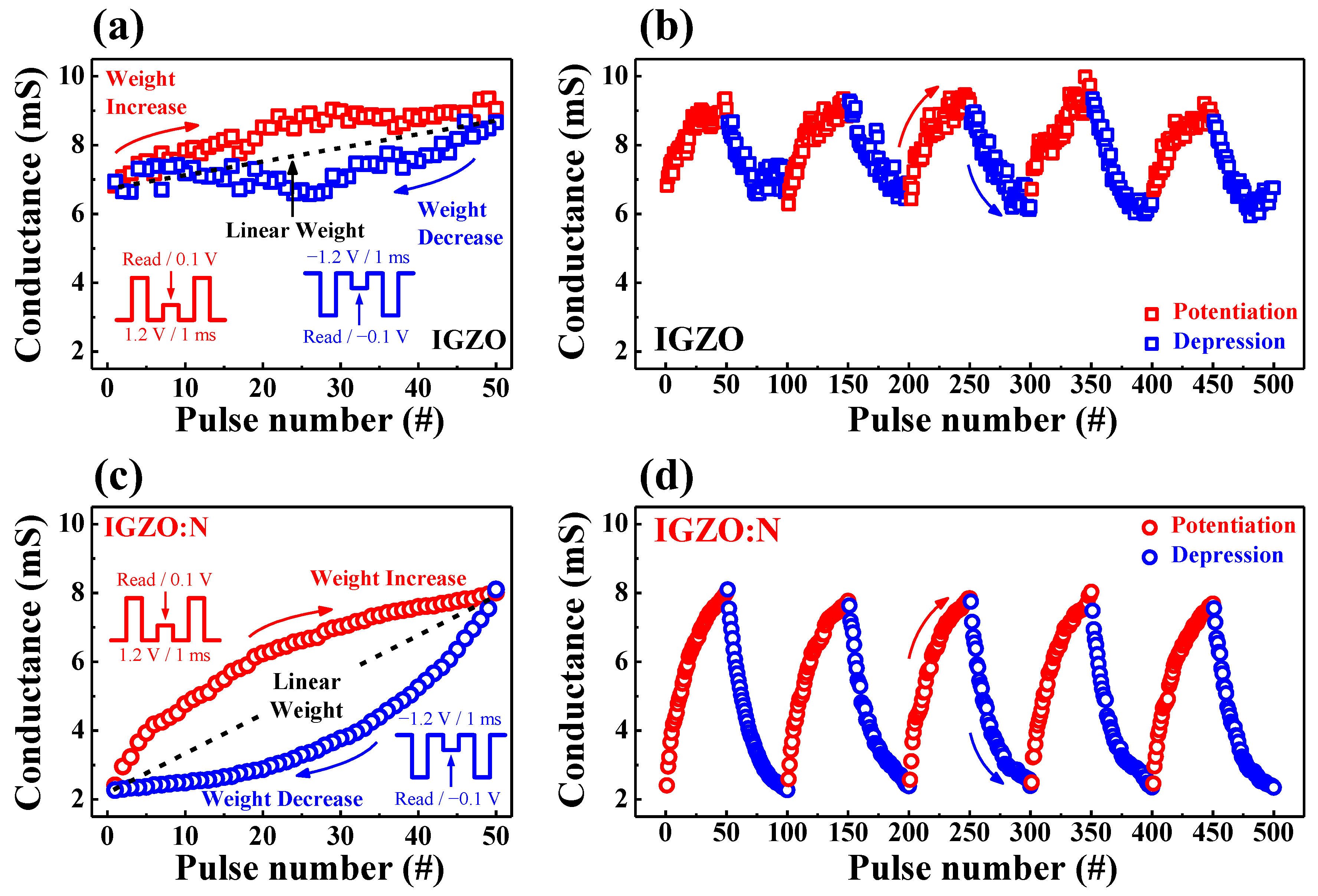
| X-ray Photoelectron Spectroscopy | ||||||||||
|---|---|---|---|---|---|---|---|---|---|---|
| Orbital | In 3d3/2 | Ga 2p3/2 | Zn 2p3/2 | |||||||
| Chemical bond | In-In | In-N | In-O | Ga-Ga | Ga-N | Ga-O | Zn-Zn | Zn-N | Zn-O | |
| Binding energy (eV) | 451.0 | 451.5 | 452.5 | 1116.6 | 1117.7 | 1118.8 | 1021.7 | 1021.9 | 1022.4 | |
| Atomic Concentration (%) | ||||||||||
| RS layer | IGZO | 50.9 | 19.1 | 30.0 | 52.9 | 28.5 | 18.6 | 47.2 | 11.6 | 41.2 |
| IGZO:N | 60.3 | 23.8 | 15.9 | 57.3 | 34.1 | 8.6 | 58.2 | 31.7 | 10.1 | |
| X-ray Photoelectron Spectroscopy | ||||
|---|---|---|---|---|
| Orbital | O 1s | |||
| Chemical bond | M-O | M-Ovac | M-OH | |
| Binding energy (eV) | 529.0 | 530.0 | 531.0 | |
| Atomic Concentration (%) | ||||
| RS layer | IGZO | 79.5 | 14.6 | 5.9 |
| IGZO:N | 56.2 | 35.0 | 8.8 | |
| Device | Parameter | Average (μ) | Standard Deviation (σ) | μ ± σ |
|---|---|---|---|---|
| IGZO Memristor | Resistance value (HRS) | 4.02 × 102 Ω | 7.52 × 102 Ω | 4.02 × 102 ± 7.52 × 102 Ω |
| Resistance value (LRS) | 6.70 × 101 Ω | 1.04 × 101 Ω | 6.70 × 101 ± 1.04 × 101 Ω | |
| Set voltage (Vset) | 0.71 V | 0.05 V | 0.71 ± 0.05 V | |
| Reset voltage (Vreset) | −0.74 V | 0.08 V | −0.74 ± 0.08 V | |
| Power for set process (Pset) | 8.23 mW | 1.96 mW | 8.23 ± 1.96 mW | |
| Power for reset process (Preset) | 7.06 mW | 0.51 mW | 7.06 ± 0.51 mW | |
| IGZO:N Memristor | Resistance value (HRS) | 8.30 × 102 Ω | 3.40 × 101 Ω | 8.30 × 102 ± 3.40 × 101 Ω |
| Resistance value (LRS) | 8.95 × 101 Ω | 2.01 × 100 Ω | 8.95 × 101 ± 2.01 × 100 Ω | |
| Set voltage (Vset) | 0.78 V | 0.03 V | 0.78 ± 0.03 V | |
| Reset voltage (Vreset) | −0.67 V | 0.02 V | −0.67 ± 0.02 V | |
| Power for set process (Pset) | 7.82 mW | 0.27 mW | 7.82 ± 0.27 mW | |
| Power for reset process (Preset) | 5.95 mW | 0.24 mW | 5.95 ± 0.24 mW |
| Multi-Level State | LRS | HRS 1 | HRS 2 | HRS 3 | HRS 4 | HRS 5 | HRS 6 |
|---|---|---|---|---|---|---|---|
| Reset stop voltage | - | −0.7 V | −0.8 V | −0.9 V | −1.0 V | −1.1 V | −1.2 V |
| Average (μ) | 8.92 × 101 Ω | 1.64 × 102 Ω | 3.24 × 102 Ω | 5.51 × 102 Ω | 8.68 × 102 Ω | 1.47 × 103 Ω | 2.32 × 103 Ω |
| Standard Deviation (σ) | 1.77 × 100 Ω | 3.94 × 100 Ω | 8.77 × 100 Ω | 1.13 × 101 Ω | 3.57 × 101 Ω | 7.73 × 101 Ω | 7.78 × 101 Ω |
Publisher’s Note: MDPI stays neutral with regard to jurisdictional claims in published maps and institutional affiliations. |
© 2021 by the authors. Licensee MDPI, Basel, Switzerland. This article is an open access article distributed under the terms and conditions of the Creative Commons Attribution (CC BY) license (https://creativecommons.org/licenses/by/4.0/).
Share and Cite
Min, S.-Y.; Cho, W.-J. High-Performance Resistive Switching in Solution-Derived IGZO:N Memristors by Microwave-Assisted Nitridation. Nanomaterials 2021, 11, 1081. https://doi.org/10.3390/nano11051081
Min S-Y, Cho W-J. High-Performance Resistive Switching in Solution-Derived IGZO:N Memristors by Microwave-Assisted Nitridation. Nanomaterials. 2021; 11(5):1081. https://doi.org/10.3390/nano11051081
Chicago/Turabian StyleMin, Shin-Yi, and Won-Ju Cho. 2021. "High-Performance Resistive Switching in Solution-Derived IGZO:N Memristors by Microwave-Assisted Nitridation" Nanomaterials 11, no. 5: 1081. https://doi.org/10.3390/nano11051081
APA StyleMin, S.-Y., & Cho, W.-J. (2021). High-Performance Resistive Switching in Solution-Derived IGZO:N Memristors by Microwave-Assisted Nitridation. Nanomaterials, 11(5), 1081. https://doi.org/10.3390/nano11051081






